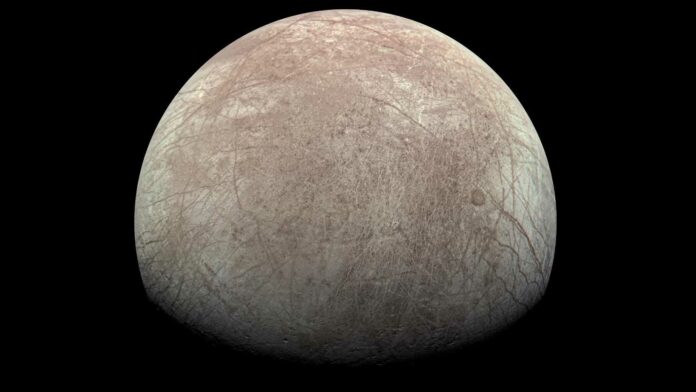The majority of Europa, one of Jupiter’s moons, is composed of water ice. However, the hostile space environment this surface is subjected to continuously modifies it. Water molecules dissociate due to charged particles breaking away the molecular bonds in the ice.
The oxygen (O2) and hydrogen (H2) produced by this process can oxygenate the underground ocean of Europa. These molecules are thought to make up most of Europa’s atmosphere.
Although the atmosphere of Europa has been better understood through remote studies, the amount of molecular oxygen (O2) has been deduced indirectly through observations of atomic oxygen emissions. The composition of Europa’s atmosphere has never been properly sampled before, and estimates of the amount of oxygen produced varied greatly, ranging over many orders of magnitude.
In a new study, scientists with NASA’s Juno mission report direct observations of H2+ and O2+ pickup ions from the dissociation of Europa’s water-ice surface and confirm these species are primary atmospheric constituents. They have also calculated the rate of oxygen production at the Jovian moon Europa.
The findings suggest that the ice-covered Jovian moon generates 1,000 tons of oxygen every 24 hours – enough to keep a million humans breathing daily.
At 2:36 p.m. PDT on September 29, 2022, when the Juno spacecraft neared Europa to within 220 miles (354 kilometers), its JADE sensor identified and recorded hydrogen and oxygen ions. These ions were created when charged particles hit the surface of Europa. Then, as Juno zipped by the moon, the ions were “picked up” by Jupiter’s magnetic field.
Scientists reached this conclusion by measuring hydrogen outgassing from the icy moon’s surface using data from the spacecraft’s Jovian Auroral Distributions Experiment (JADE) instrument.
According to the paper’s authors, some 26 pounds (12 kilograms) of oxygen are created on Europa every second. Estimates from the past have ranged wildly, from a few pounds to more than 2,000 pounds (more than 1,000 kilograms) every second.
Scientists believe that a portion of this oxygen may find its way into the ocean beneath Europa, where it might provide energy for subterranean life.
Europa is the smallest of the four Galilean satellites and the fourth biggest of Jupiter‘s 95 known moons, with an equatorial diameter of 1,940 miles (3,100 kilometers). According to scientists, its massive interior ocean of salt water is thought to exist beneath its ice surface. Their focus lies on investigating the potential existence of life-sustaining conditions beneath Europa’s surface.
Indeed, it’s not just the water that interests astrobiologists about Europa. Its location in Jupiter’s orbit is also significant for biological possibilities. Europa sits right in the middle of Jupiter’s radiation belts.
These belts are filled with charged particles, or ions, bombard Europa’s icy surface. This constant bombardment splits water molecules apart, generating oxygen. Some of this oxygen may then make its way into Europa’s ocean, adding to the intrigue surrounding the potential for life on Europa.
JADE scientist Jamey Szalay from Princeton University in New Jersey said, “Europa is like an ice ball slowly losing its water in a flowing stream. Except, in this case, the stream is a fluid of ionized particles swept around Jupiter by its extraordinary magnetic field.”
“When these ionized particles impact Europa, they break up the water-ice molecule by molecule on the surface to produce hydrogen and oxygen. In a way, the entire ice shell is being continuously eroded by waves of charged particles washing up upon it.”
Journal Reference:
- Szalay, J.R., Allegrini, F., Ebert, R.W. et al. Oxygen production from dissociation of Europa’s water-ice surface. Nat Astron (2024). DOI: 10.1038/s41550-024-02206-x
